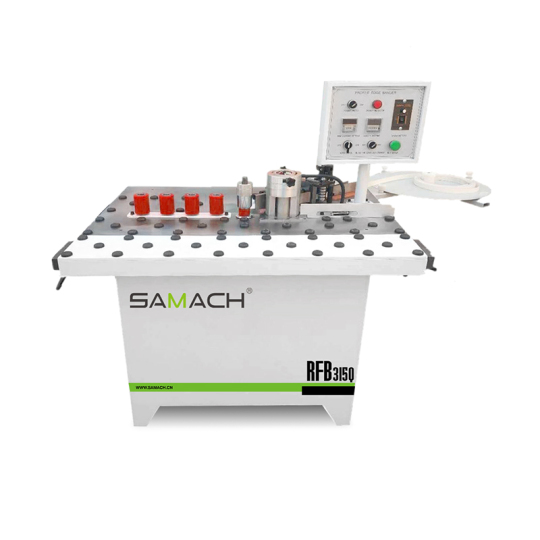
## Why Edge Banding Machines Still Matter in 2025
In modern cabinet and furniture production, the Edge Banding Machine delivers seamless results and durable performance by sealing exposed panel sides with PVC, ABS, veneer, or melamine.
Whether you run a small custom shop or a multi-shift plant, the right edgebander raises quality while shortening changeovers.
## Edge Banding Machine: Definition
An Edge Banding Machine applies a narrow strip of material to raw panel edges and then trims it for a seamless look.
Key steps: prepare edge, adhere tape, bond, cut overhang, profile, and scrape/buff.
## How It Works: Step-by-Step
1. Panel In-feed — A guided in-feed keeps parts straight and stable.
2. Pre-milling — Remove 0.3–1.0 mm to eliminate saw chatter and out-of-square conditions.
3. Adhesive — Thin, consistent glue lines improve durability.
4. Tape Bonding — Controlled pressure ensures a tight joint.
5. End Trimming — Remove overhang at leading/trailing edges.
6. Top/Bottom Trim — High-speed cutters for crisp lines.
7. Corner Rounding (if equipped) — Improves safety and aesthetics.
8. Scraping & Buffing — Scrapers remove micro-lip.
## Edge Bander Types
• Manual/Portable — lowest cost, on-site fixes, but variable quality and slow throughput.
• Starter Auto — simple stations, good upgrade from manual methods.
• Mid-Tier — better finish (pre-mill + corner round), faster changeovers, lower rework.
• Industrial/High-End — zero-joint (hot-air/laser), servo stations, high feed speed, line integration.
• Contour/Curve — for irregular parts; often needs special tapes or adhesives.
## EVA vs PUR vs Zero-Joint
• EVA Hot-Melt — affordable and easy to clean, but lower heat/moisture resistance and more visible glue lines on dark colors.
• PUR Hot-Melt — thin glue line, excellent resistance, strongest bond; requires strict handling/cleaning.
• Zero-Joint — no liquid glue pot; perfect aesthetics with matched functional layers.
Tip: Stock EVA + PUR if your machine supports quick glue-pot swaps.
## What to Look For in a Machine
• Feed speed — go as fast as quality allows; align with cutting capacity.
• Thickness range — ensure it fits your product mix.
• Edge tape — specify by décor and durability goals.
• Edge prep — invest here for visible quality gains.
• Corners — important for doors/drawer fronts.
• Fine finish — fewer tool marks, even sheen.
• Glue tech — drives TCO, appearance, and process control.
• Control — recipe library reduces operator error.
• Dust extraction — ports per station protect finish and health.
• Switchover — faster changes, higher OEE.
• Utilities — verify power, air, space.
## Best-Fit Recommendations
• Custom shops — choose pre-mill + PUR, rounding, smart controls.
• Commercial millwork/furniture — industrial model with servo stations, high speed, auto setups, in-line QC.
• Premium aesthetics — hot-air/laser for invisible seams.
• RTA/flat-pack — industrial line, 2–3 mm tape capability, strong extraction, auto lube, buffers.
• New to automation — basic auto bander; focus on stability.
## Daily Habits That Pay Off
• Stabilize environment; verify three-phase power, air, and dust website extraction.
• Avoid over-cutting; minimal removal preserves time and material.
• Follow adhesive curves; purge and clean on schedule.
• Right pressure equals tight, clean seams.
• Keep cutters sharp; dull tools cause fuzzing/tear-out (especially veneer).
• Clean squeeze-out immediately; use proper PUR cleaners and timing.
• Train safety: guards, E-stops, LOTO, PPE, hot surfaces.
## Troubleshooting Common Defects
• Visible glue line — raise temp within spec, add pressure, verify pre-mill; consider PUR/zero-joint for dark/gloss.
• Peeling at corners — adjust rounding and adhesion window.
• Veneer tear-out/chatter — sharpen tools, slow feed, optimize cutter geometry.
• Squeeze-out/smearing — reduce glue or pressure; clean promptly.
• Drift — inspect guides and tape tensioners.
## Choosing Edge Banding Materials
PVC/ABS are workhorses with broad décor ranges; wood veneer looks premium but needs sharp tooling; melamine is thin and economical; aluminum/acrylic are design options requiring slower feeds.
For zero-joint, ensure tapes include a compatible functional layer and that its color hides the seam.
## Integrating Into a CNC Cell
Use barcodes/recipes, buffers, and conveyors to cut walking time.
## Greener Edge Banding Choices
Choose adhesives/tapes that reduce emissions; invest in filtration.
## Edge Banding Machine FAQs
Best speed? No universal value—optimize per material.
EVA vs PUR? EVA is cheaper to clean; PUR bonds stronger with a thinner line.
Pre-milling? Upgrades finish.
Zero-joint? Invisible lines.
When to sharpen? Plan by volume.
## Bottom Line
With solid setup and maintenance, the right edgebander elevates finish on every project. }